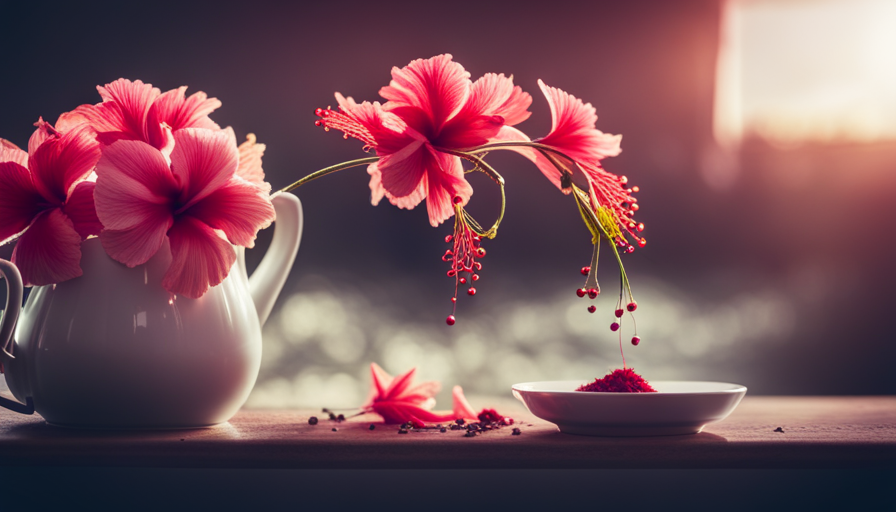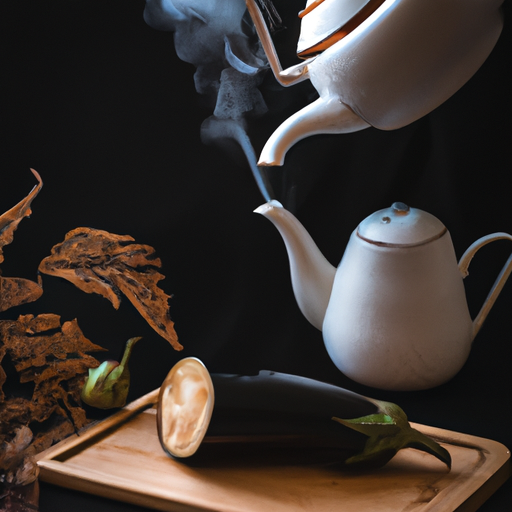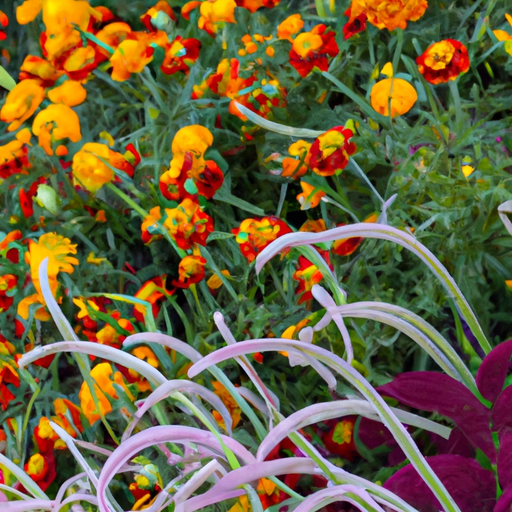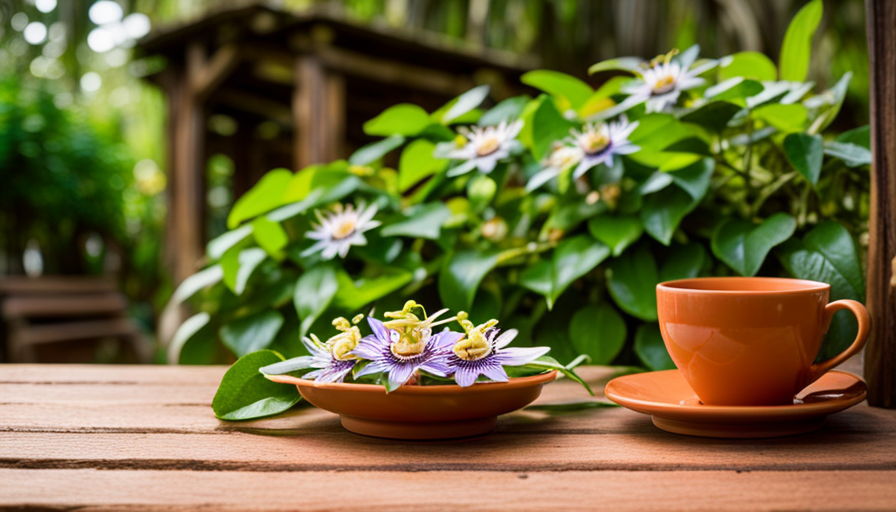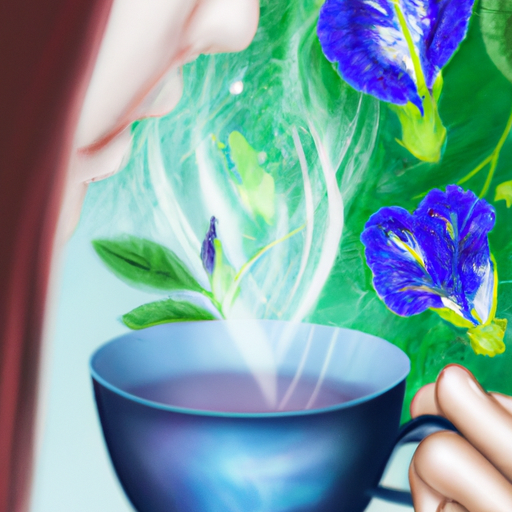Picture a lively red flower blooming gently in your teacup, filling the air with its exotic scent. That is the magical experience you can craft with hibiscus flower tea.
As a tea enthusiast, I have discovered the art of making this invigorating beverage, and I am thrilled to share my knowledge with you. In this article, I will guide you through the step-by-step process of crafting a perfect cup of hibiscus flower tea. From selecting the finest hibiscus flowers to experimenting with delightful flavor combinations, I will equip you with all the necessary tools and techniques to create a tea that will awaken your senses.
So, grab your teapot and join me on this captivating journey to brew a cup of hibiscus flower tea that will transport you to a tropical paradise.
Let’s get started!
Key Takeaways
- Hibiscus flower tea offers a vibrant crimson color and exotic aroma.
- High-quality flowers and proper preparation techniques are key to crafting a perfect cup.
- The tea provides various health benefits, including antioxidants, heart health support, weight management, and digestion aid.
- Straining the tea is essential, and there are different options available such as fine mesh strainers, cheesecloth, tea infusers, or coffee filters.
Gather the Ingredients and Tools
Get ready to make some delicious hibiscus flower tea by gathering all the ingredients and tools you’ll need! Hibiscus flower tea is not only refreshing but also packed with numerous health benefits.
To start, you’ll need high-quality hibiscus flowers, which come in various types such as Hibiscus sabdariffa and Hibiscus rosa-sinensis. Each type has its own unique flavor profile, ranging from tangy and citrusy to slightly sweet and floral. Experimenting with different types can add depth to your tea and cater to your personal taste preferences.
Apart from its delightful taste, hibiscus flower tea offers a range of health benefits. It’s known to have antioxidant properties, which can help protect against cell damage and reduce inflammation. Additionally, hibiscus tea has been found to have potential benefits for heart health, as it may help lower blood pressure and cholesterol levels. It’s also believed to aid in weight management and digestion.
With these facts in mind, it’s important to choose high-quality hibiscus flowers for your tea. This ensures that you’re getting the maximum flavor and health benefits from your brew.
So, let’s move on to the next section where we discuss how to select the best hibiscus flowers for your tea.
Choose High-Quality Hibiscus Flowers
To ensure a flavorful and vibrant brew, opt for hibiscus blossoms that are like a burst of sunshine in a cup. When choosing high-quality hibiscus flowers for making tea, it’s important to consider their drying method. Look for flowers that have been air-dried or sun-dried rather than those that have been machine-dried, as the latter can result in a loss of flavor and aroma.
Air-dried flowers tend to retain more of their natural qualities, ensuring a richer and more satisfying tea experience.
In addition to their delightful taste, hibiscus flowers offer numerous health benefits. They’re packed with antioxidants that help fight free radicals in the body, promoting overall wellbeing. Hibiscus tea is also known for its potential to lower blood pressure and cholesterol levels. It may even aid in weight loss by suppressing appetite and boosting metabolism. Furthermore, hibiscus tea is believed to have antimicrobial properties, supporting a healthy immune system.
Now that you’ve chosen your high-quality hibiscus flowers, it’s time to move on to the next step: rinsing the flowers.
Rinse the Flowers
After selecting the high-quality hibiscus blossoms, it’s time to give them a gentle rinse before incorporating them into your brew. Rinsing the flowers is an essential step in preparing hibiscus flower tea, as it helps to remove any dirt or impurities that may be present. There are different methods of drying hibiscus flowers, but regardless of which method you choose, it’s important to ensure that they are fully dry before rinsing them. This can be done by air-drying them for a few days or using a dehydrator. Once the flowers are dry, place them in a colander and rinse them under cold, running water. Gently swish them around to remove any remaining dirt or debris.
To further enhance the quality of your hibiscus flower tea, it is recommended to use filtered water. Filtered water helps to remove impurities and chlorine, resulting in a cleaner and more flavorful brew. It also prevents any unwanted tastes or odors from affecting the final taste of the tea. By using filtered water, you can fully enjoy the natural flavors and benefits of the hibiscus flowers.
After rinsing the flowers and preparing the filtered water, it’s time to move on to the next step: boiling the water. This crucial step will ensure that the flowers release their vibrant colors and flavors into the tea.
Boil Water
Bring your water to a rolling boil, like a raging river that carries the essence of the hibiscus flowers on its powerful current. When making hibiscus flower tea, it’s important to choose the right temperature for boiling the water. The ideal temperature is around 212°F (100°C), which is the boiling point for water at sea level. This temperature ensures that the water extracts the maximum flavor and health benefits from the hibiscus flowers.
In addition to the temperature, the type of water you use can also affect the taste of your tea. For the best results, use filtered or spring water instead of tap water. Tap water may contain impurities or chlorine that can alter the flavor of the tea. Filtered or spring water, on the other hand, provides a clean and pure base for brewing the hibiscus flowers.
Once your water is boiling, carefully pour it over the rinsed hibiscus flowers in your teapot or mug. This will begin the steeping process, where the flavor and color of the flowers infuse into the water. Be sure to cover the container to retain the heat and let the hibiscus flowers steep for about 5 to 10 minutes.
With the water boiled and the hibiscus flowers steeping, the next step is to enjoy the delightful aroma and taste of your homemade hibiscus flower tea.
Steep the Hibiscus Flowers
As you’re boiling water cascades over the vibrant hibiscus petals, let the infusion of flavors transport you to a tropical paradise. Steeping hibiscus flowers is a simple process that can be done using different methods.
One popular method is to pour the boiling water over the flowers and let them steep for about 5-10 minutes. This allows the flavors and nutrients to be extracted, resulting in a rich and refreshing tea. Another method is to use a tea infuser or a tea bag filled with hibiscus flowers, which makes it easier to remove the petals after steeping.
Not only does hibiscus flower tea taste delicious, but it also offers various health benefits. It’s known for its high content of antioxidants, which help protect the body against damage from harmful free radicals. The tea is also rich in vitamin C, which boosts the immune system and promotes overall health. Additionally, hibiscus flower tea has been shown to lower blood pressure, reduce cholesterol levels, and aid in weight loss.
As you savor the delicate flavors of hibiscus flower tea, consider adding a sweetener if desired. Stay tuned for the next step, where I’ll guide you through the process of adding sweetener (optional).
Add Sweetener (Optional)
Enhance your tropical paradise experience by adding a touch of sweetness to your refreshing hibiscus infusion. When it comes to choosing a sweetener for your hibiscus flower tea, you have a few options to consider.
The most common choices are sugar and honey, both of which can complement the tart flavor of hibiscus quite well. If you prefer a more traditional and straightforward sweetness, sugar can be a great choice. Its granulated form dissolves easily in hot water, making it convenient to use.
On the other hand, if you’re looking for a natural alternative, honey is a wonderful option. Its subtle floral notes can harmonize with the hibiscus, creating a delightful flavor combination. Additionally, honey offers potential health benefits, such as soothing a sore throat or boosting your immune system.
If you’re looking to explore other sweetener options, you can experiment with stevia, agave syrup, or maple syrup. These alternatives can provide different flavor profiles and can be suitable for those with dietary restrictions.
Now that we’ve added sweetness to our hibiscus infusion, let’s move on to the next step: straining the tea.
Strain the Tea
To fully enjoy your tropical paradise experience, you’ll need to strain the vibrant infusion of hibiscus goodness that you’ve created. Straining the tea is an essential step that ensures a smooth and enjoyable drinking experience.
There are different methods you can use to strain your hibiscus flower tea, depending on your preference and the tools you have available. Here are four options to consider:
-
Fine mesh strainer: This is a popular choice for its ability to remove all the small particles and sediment from the tea, resulting in a clear and visually appealing drink.
-
Cheesecloth: If you prefer a more rustic and natural approach, using a cheesecloth can effectively strain the tea while still allowing some of the finer particles to remain, giving the drink a slightly textured mouthfeel.
-
Tea infuser: For a quick and convenient method, using a tea infuser with fine holes will effectively strain the tea while keeping all the loose leaves contained.
-
Coffee filter: If you don’t have any specialized tea strainers at hand, a coffee filter can serve as a makeshift strainer. It may take a bit longer for the tea to strain through, but it will still remove most of the sediment.
Using a fine mesh strainer offers the benefit of effectively removing any small particles, resulting in a visually appealing and smooth tea. Once you’ve strained the tea, it’s time to serve and enjoy your refreshing hibiscus flower infusion.
Serve and Enjoy
Indulge in the delightful experience of savoring your tropical paradise creation by serving and relishing every sip of the invigorating hibiscus infusion. There are various ways to serve hibiscus tea, allowing you to explore and enjoy its flavors in different forms.
One popular option is to serve it hot, which brings out the rich and vibrant taste of the tea. You can also serve it over ice for a refreshing and cooling beverage, perfect for a hot summer day. If you prefer a sweeter taste, you can add a touch of honey or a splash of lemon juice to enhance the flavor profile.
Aside from its delicious taste, hibiscus tea also offers numerous health benefits. It is known to be rich in antioxidants, which can help protect your body against harmful free radicals. It may also help lower blood pressure and cholesterol levels, promoting heart health. Additionally, hibiscus tea has been shown to have anti-inflammatory properties and may aid in digestion.
As you explore the different ways to serve and enjoy hibiscus tea, you can begin to experiment with flavor combinations. In the next section, we will delve into the exciting world of creating unique and tantalizing flavors by combining hibiscus tea with various ingredients.
Experiment with Flavor Combinations
Get ready to embark on a flavor adventure as you explore the exciting world of mixing hibiscus tea with a variety of ingredients. Experimenting with different herbal blends allows you to create unique flavor profiles that will tantalize your taste buds and keep you coming back for more.
One interesting combination to try is hibiscus tea infused with mint leaves and a squeeze of fresh lemon juice. The refreshing mint adds a cool twist to the floral notes of the hibiscus, while the lemon adds a tangy brightness that complements the tea perfectly.
Another option is to mix hibiscus tea with a touch of ginger and a sprinkle of cinnamon for a warming and spicy twist. The ginger adds a subtle heat, while the cinnamon adds a comforting sweetness.
The possibilities are endless, so don’t be afraid to get creative and explore different flavor combinations that suit your taste preferences.
Now that you have experimented with various flavor profiles, it’s time to store the leftover tea.
Store the Leftover Tea
Now that you’ve experimented with different flavor combinations for your hibiscus flower tea, let’s talk about how to properly store the leftover tea to preserve its freshness.
As a tea enthusiast myself, I understand the importance of keeping tea fresh and flavorful for as long as possible. To begin, it’s crucial to store the leftover tea in an airtight container. This will prevent any moisture or odors from seeping in and affecting the taste. I recommend using a glass jar or a tin container, as they’re excellent at maintaining freshness.
Once you have the tea stored properly, there are several creative ways you can make use of the leftovers. One option is to make iced tea by simply refrigerating the tea and adding some ice cubes for a refreshing summer drink. Another idea is to use the leftover tea as a base for homemade popsicles. Simply mix in some fruit juice or chopped fruits, pour the mixture into popsicle molds, and freeze.
If you’re feeling more adventurous, you can even incorporate the leftover tea into your baking. Try adding it to cake or cookie recipes for a unique twist of flavor. The floral notes of hibiscus can add a delightful touch to your baked goods.
By following these tips for storing and creatively using your leftover hibiscus flower tea, you can continue to enjoy its freshness and explore new ways to incorporate it into your daily routine.
Frequently Asked Questions
How long should I steep the hibiscus flowers to get the best flavor?
To achieve the best flavor when steeping hibiscus flowers, it’s recommended to steep them for about 5-10 minutes. This allows the flowers to release their vibrant color and tart flavor into the tea.
For maximum flavor, consider adding a squeeze of lemon juice or a dash of honey to enhance the hibiscus’s natural tanginess.
By steeping the flowers for the right amount of time and incorporating these flavor-enhancing tips, you can create a delicious and refreshing hibiscus flower tea.
Can I use dried hibiscus flowers instead of fresh ones?
Yes, you can definitely use dried hibiscus flowers in your hibiscus flower tea recipe. Dried flowers are a convenient and shelf-stable option that still provide a robust flavor. To make the tea, simply steep the dried hibiscus flowers in hot water for about 5-10 minutes, depending on your desired strength. Strain the flowers and enjoy a refreshing and vibrant cup of hibiscus flower tea.
What type of sweetener works best with hibiscus flower tea?
When it comes to selecting a sweetener for hibiscus flower tea, there are several options to consider. The choice ultimately depends on your flavor preferences. Some popular sweetener options include honey, agave syrup, and stevia. Honey adds a subtle floral sweetness, while agave syrup provides a smoother taste. Stevia, a natural sweetener, is a great choice for those watching their sugar intake. Experiment with different sweeteners to find the perfect balance for your hibiscus flower tea.
How long can I store the leftover hibiscus flower tea?
The shelf life of leftover hibiscus flower tea depends on how it’s stored. To ensure its freshness, I recommend transferring the tea into an airtight container and refrigerating it. When stored properly, hibiscus flower tea can last for up to 3-4 days in the refrigerator. However, it’s important to note that the flavor and quality may diminish over time. Therefore, it’s best to consume it within a few days for the best taste.
Are there any potential health benefits associated with drinking hibiscus flower tea?
There are potential health benefits associated with drinking hibiscus flower tea. It’s believed to help lower blood pressure and reduce cholesterol levels. Additionally, hibiscus tea is rich in antioxidants that can help protect against cell damage and inflammation. However, it’s important to note that excessive consumption may lead to potential side effects such as stomach discomfort and dehydration. It’s generally recommended to consume hibiscus tea in moderation, with a recommended daily intake of 2-3 cups.
Conclusion
In conclusion, making hibiscus flower tea is a simple and enjoyable process that can be done at home. By following the steps outlined in this article, you can create a delicious and refreshing beverage.
Did you know that hibiscus tea has been enjoyed for centuries and is known for its health benefits? Studies have shown that hibiscus tea may help lower blood pressure and cholesterol levels.
So, why not give it a try and reap the benefits of this beautiful flower?

